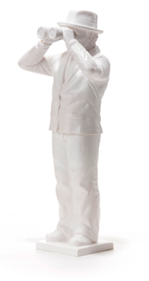
Ihr Warenkorb ist leer.


Ihr Warenkorb ist leer.

Among the repeatedly employed icons in Ottmar Hörl's work are the "Sculptures in the Gordian Style". They are based on empty tubes for underground installation (e.g. for electricity cables) available in different colours in any DIY shop. The artist discovers the sculptural and graphic qualities of the material. He discovers the "natural" talent of the tube: its flexibility, its pliancy and its versatility. And he finally combines it in his sculpture with the ancient myth of the Gordian knot, indissoluble, without beginning or end. The problem of untying this knot named after Gordios, the mythical founder of the Phrygian empire and father of Midas, who was famous for his wealth, was, according to tradition, associated with the rule over Asia. In 334 B.C., the state in Asia Minor and its capital Gordium fell to Alexander the Great, who is said to have cut the knot with a stroke of his sword. Ottmar Hörl turns the industrial material into the visual carrier of a myth. He plainly shows its flexibility and convertibility: the object remains what it is, keeps its identity, and yet gains mythical pictorial appearance and significance, becoming a symbol of a problem as such, which even antiquity's brilliant military leader was only able to solve with brute force – because the Gordian knot not only represented a riddle however to be solved, but also a mystery. This sculpture, too, is a three-dimensional event, a metaphor for an order created according to certain rules and indissoluble disorder, as it can only be returned to its original state as a ready-made by brute force ... The ready-made as a found, industrially manufactured product, and the sculpture as a three-dimensional organisational principle are indissolubly connected in Ottmar Hörl's body of work. [1]
Ottmar Hörl has been developing his "Sculptures in the Gordian Style", which he has been developing since the mid-1990s, and which he realized for the first time as a large-scale sculpture in this dimension in 1998 on the occasion of the exhibition project in the Wewerka pavilion, "refer to the fact that there are problems for which there may be no solution."[2]
[1] See: Werner Meyer, Ottmar Hörl. Problemlösung. Skulptur als Organisationsprinzip, exhibition catalogue, Johannes Gutenberg University Mainz, Todtnau im Schwarzwald, 2002, p. 11-12
[2] Ottmar Hörl, An Address to Humanity, 2010, p. 157